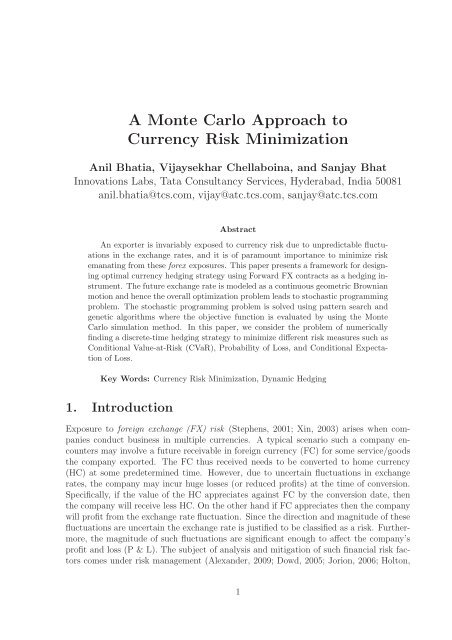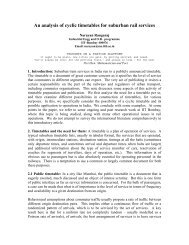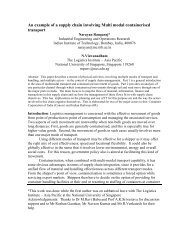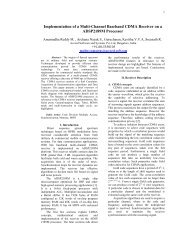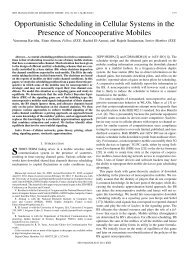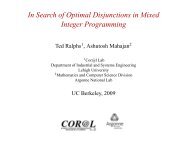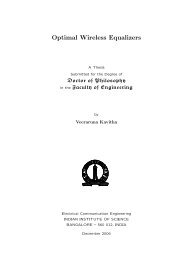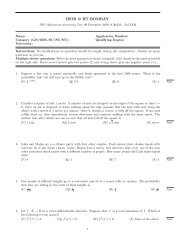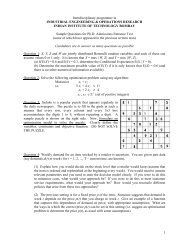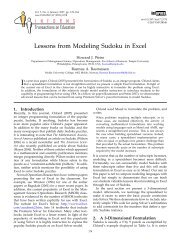A Monte Carlo Approach to Currency Risk Minimization - IEOR @IIT ...
A Monte Carlo Approach to Currency Risk Minimization - IEOR @IIT ...
A Monte Carlo Approach to Currency Risk Minimization - IEOR @IIT ...
You also want an ePaper? Increase the reach of your titles
YUMPU automatically turns print PDFs into web optimized ePapers that Google loves.
A <strong>Monte</strong> <strong>Carlo</strong> <strong>Approach</strong> <strong>to</strong><strong>Currency</strong> <strong>Risk</strong> <strong>Minimization</strong>Anil Bhatia, Vijaysekhar Chellaboina, and Sanjay BhatInnovations Labs, Tata Consultancy Services, Hyderabad, India 50081anil.bhatia@tcs.com, vijay@atc.tcs.com, sanjay@atc.tcs.comAbstractAn exporter is invariably exposed <strong>to</strong> currency risk due <strong>to</strong> unpredictable fluctuationsin the exchange rates, and it is of paramount importance <strong>to</strong> minimize riskemanating from these forex exposures. This paper presents a framework for designingoptimal currency hedging strategy using Forward FX contracts as a hedging instrument.The future exchange rate is modeled as a continuous geometric Brownianmotion and hence the overall optimization problem leads <strong>to</strong> s<strong>to</strong>chastic programmingproblem. The s<strong>to</strong>chastic programming problem is solved using pattern search andgenetic algorithms where the objective function is evaluated by using the <strong>Monte</strong><strong>Carlo</strong> simulation method. In this paper, we consider the problem of numericallyfinding a discrete-time hedging strategy <strong>to</strong> minimize different risk measures such asConditional Value-at-<strong>Risk</strong> (CVaR), Probability of Loss, and Conditional Expectationof Loss.Key Words: <strong>Currency</strong> <strong>Risk</strong> <strong>Minimization</strong>, Dynamic Hedging1. IntroductionExposure <strong>to</strong> foreign exchange (FX) risk (Stephens, 2001; Xin, 2003) arises when companiesconduct business in multiple currencies. A typical scenario such a company encountersmay involve a future receivable in foreign currency (FC) for some service/goodsthe company exported. The FC thus received needs <strong>to</strong> be converted <strong>to</strong> home currency(HC) at some predetermined time. However, due <strong>to</strong> uncertain fluctuations in exchangerates, the company may incur huge losses (or reduced profits) at the time of conversion.Specifically, if the value of the HC appreciates against FC by the conversion date, thenthe company will receive less HC. On the other hand if FC appreciates then the companywill profit from the exchange rate fluctuation. Since the direction and magnitude of thesefluctuations are uncertain the exchange rate is justified <strong>to</strong> be classified as a risk. Furthermore,the magnitude of such fluctuations are significant enough <strong>to</strong> affect the company’sprofit and loss (P & L). The subject of analysis and mitigation of such financial risk fac<strong>to</strong>rscomes under risk management (Alexander, 2009; Dowd, 2005; Jorion, 2006; Hol<strong>to</strong>n,1
2003) and the specific case of exchange rate risk comes under currency risk management(Stephens, 2001; Xin, 2003).<strong>Risk</strong> management consists primarily of an accurate analysis of the risk fac<strong>to</strong>rsinvolved(FX rate, in this case) and take appropriate action <strong>to</strong> mitigate the risk. Any such actionis known as hedging. There are many alternatives available <strong>to</strong> the company for hedgingincluding conversion of FC <strong>to</strong> HC at an appropriate time or enter in<strong>to</strong> different hedgingcontracts with some financial institution. Such contracts may involve FX instruments(also known as hedges) such as forwards, futures, swaps, and a variety of FX options(Stephens, 2001; Xin, 2003). Specifically, a FX forward is an agreement between thetwo parties <strong>to</strong> exchange currencies, namely, <strong>to</strong> buy or sell a particular currency at apredetermined future date and a predetermined exchange rate. It costs nothing <strong>to</strong> entera forward contract. The party agreeing <strong>to</strong> buy the currency in the future assumes along position, and the party agreeing <strong>to</strong> sell the currency in the future assumes a shortposition. The price agreed upon is called the delivery price, which is equal <strong>to</strong> the forwardrate at the time of initiation of the contract. An option sets a rate at which the companymay choose <strong>to</strong> exchange currencies. If the exchange rate at option maturity is morefavorable, then the company will not exercise this option. Forward FX contracts areconsidered <strong>to</strong> be the simplest and the most widely used instrument for currency hedging.Their popularity may be partially explained by their simplicity, their initial zero cost, andfeasibility of over-the-counter (OTC) trading that permits exact specifications regardingdates and amounts. In this paper, we primary focus on optimal hedging problem usingForward FX contracts as a hedging instrument although the overall methodology caneasily be extended <strong>to</strong> include other instruments. For a general introduction <strong>to</strong> various(equity-based) financial instruments and their utility in heading, see Wilmott (2007); Hull(2008).Ahedging strategy represents atradingstrategyinvolving differenttypesofhedgesthatcan reduce currency risk. The hedging strategy typically depends on information such asexchange rate fluctuations and possibly a predictive model for the exchange rate (the socalled market view). These hedging schemes involve forward-rate based transactions <strong>to</strong>essentially lock infutureexchange rate. Suppose a company isexpecting a certain amoun<strong>to</strong>fFCatafuturedate. Thecompanyhasachoiceofdoingnothing(no hedging),enter in<strong>to</strong>a hedging contract once (static hedging), or enter in<strong>to</strong> multiple contracts at different times(dynamic hedging). The choice depends on various reasons including the companies viewon the market and service costs <strong>to</strong> enter hedging contracts. If the company can eliminateorachieve minimumpossibleriskusingnohedgingorstatichedgingthendynamichedgingoffers no advantage. However, in highly volatile periods, dynamic hedging may achievesignificantly less risk compared <strong>to</strong> static hedging. <strong>Currency</strong> risk hedging remains anactiveareaofresearch(Stephens, 2001;Xin,2003;Gagnonetal.,1998;LypnyandPowalla, 1998;Campbell etal.,2010;GlenandJorion,1993;Chang,2011). Mos<strong>to</strong>ftheexisting literatureeither focuses on static hedging or specific risk measures such as variance. In this paper,we present a general framework for designing risk optimal discrete-time dynamic hedgingstrategy where the risk measure can be chosen arbitrarily.Below, we summarize our framework for obtaining the optimal hedging strategy:i) In this paper, we assume that the FX rate follows a geometric Brownian motion2
(Alexander, 2009; Wilmott, 2007). However, it should be noted that the currentframework can easily be extended <strong>to</strong> other models such as GARCH-based modelsor s<strong>to</strong>chatic volatility models.ii) In this paper, we assume that hedging can be performed at a fixed set of times,that is, the position of the forward contracts in the hedging portfolio is updated atpre-determined fixed set of times using information available up<strong>to</strong> that time. Weassume that the hedging strategy is a function of FX rates at all past and present(but not future) hedging times. In order <strong>to</strong> perform numerical optimization, weassume that this function is in terms of a finite set of paraemeters represented on ascenario tree (see below).Notethat the number of hedging times andthe hedging times can also be optimized.However, this leads <strong>to</strong> an optimal s<strong>to</strong>pping time problem, which is very difficult <strong>to</strong>solve and we do not consider it here.iii) Here, we minimize a risk metric (Artzner et al., 1999; Alexander, 2009; Dowd, 2005)defined on the P&L over the set of discrete-time hedging strategies defined on a(given) scenario tree. Though the framework allows an arbitrary risk metric, in thispaper, we only consider conditional value-at-risk (CVaR), probability of loss, andconditional expected loss. For a given hedging strategy, we first simulate sufficientlylarge number of <strong>Monte</strong> <strong>Carlo</strong> paths and then the risk metric is computed using thecorresponding P&L values. The optimal hedging strategy is obtained using either apattern search algorithm for single metric minimization and a genetic algorithm formulti-objective minimization (Doherty et al., 2004). Both these algorithms requireonly the objective function value and not its gradient information.2. No HedgingIn this section, we consider the case of no hedging. Here, we assume that a company isexpecting a foreign currency of N units at a future time T (we denote the current time <strong>to</strong>be T 0 (< T)). Furthermore, we assume that the company has an obligation (<strong>to</strong> be paid)of NB units of HC, where B is called the budget rate. Typically the budget rate B isdetermined by the company once a year based on many fac<strong>to</strong>rs such as costs and profitexpectations. Let us denote by X t the exchange rate in number of HC units for one uni<strong>to</strong>f FC at time t. If the company converts all the FC in<strong>to</strong> HC at time T then the profit/loss(P & L) ψ T is given byψ T = N(X T −B). (1)A positive ψ T represents a profit and a negative ψ T represents a loss. Since X T is arandom variable it follows that ψ T is a random variable and hence we have <strong>to</strong> use probabilitybased risk metric/measure <strong>to</strong> predict the profit/loss. A variety of risk measures areavailable <strong>to</strong> capture the randomness of ψ T (Artzner et al., 1999; Alexander, 2009; Dowd,2005). Two measures that may be used are conditional expected loss (E(ψ T |ψ T < 0))and probability of loss (P(ψ T |ψ T < 0)). Other popular measures include Value-at-<strong>Risk</strong>(VaR), the maximum likely loss <strong>to</strong> occur in (1−α)% of cases (where α is typically 95%3
or more and indicates a level of confidence), and the expected tail loss or ConditionalValue-at-<strong>Risk</strong> (CVaR). The mathematical expressions for VaR(ψ T ) and CVaR(ψ T ) aremore involved and hence we refer the reader <strong>to</strong> Alexander (2009); Dowd (2005); Jorion(2006) for a detailed study of VaR and CVaR.Notethateachofthesemeasureshavetheirownadvantagesanddisadvantages. Hence,one should look at more than one risk measure <strong>to</strong> assess the risk. If the risk measures arenot within allowable limits with no hedging then we have <strong>to</strong> consider (static or dynamic)hedging <strong>to</strong> minimize the risk. In the subsequent sections, we provide details of static anddynamic hedging.3. Static HedgingIn this paper, we consider only those hedging strategies that involve setting up a hedgingportfolio of liquid Forward FX contracts. If the company is expecting N units of FC andan obligation of NB units of HC at time T and the risk due <strong>to</strong> X T is beyond allowablelimits then the company has <strong>to</strong> employ a hedging strategy. In this section, we considerthe static hedging case where the company invests only once (at time T 0 ) in a forward FXcontract. The company has a choice of i) covering all the N units of FC, that is, enteringin<strong>to</strong> N forward contracts each of unit value, ii) covering none of the FC (though this isno hedging, it is technically a (trivial) static hedging strategy), or iii) or cover ζ 0 units ofFC. The determination of the decision variable ζ 0 (whether 0, N, or some other number)is the problem of static hedging. The objective is <strong>to</strong> minimize the risk where the P & Lwill take the formψ T = N(X T −B)+ζ 0 (F 0,T −X T ), (2)where the first term in (2) is the same as P & L expression (1) in the no hedging casewhile the second term is the P & L coming from the forward contracts. Here, F 0,T denotethe forward FX price (or forward rate) of a forward contract which is initiated at timeT 0 and matures at future date T. For simplicity it is assumed that there are no bid-askspreads in the forward contract quotes and there are no transaction costs or cost-<strong>to</strong>-carryin trading these contracts. Some of the regula<strong>to</strong>ry requirements that enforce constraintson over-hedging and under-hedging position limits are also ignored.In a given static hedging strategy the company is buying ζ 0 units of the forwardcontract atF 0,T . Thisarrangement allowsthecompany <strong>to</strong>sell FCcurrency atanexchangerate of F 0,T at time T. By locking in<strong>to</strong> a forward contract <strong>to</strong> sell FC, the company sets afuture exchange rate without any additional cost. Any remaining N −ζ 0 units of FC isthen exchanged at T (at spot rate).One way of determining ζ 0 is <strong>to</strong> proportionally cover FC based on an estimate ofprobability that X T is lower than the budget rate B. Since the case of X T < B results ina loss it may be appropriate <strong>to</strong> cover p 0 N units of FC, where p 0 is the probability suchthat X T < B. The strategy where ζ 0 = p 0 N is called static proportional strategy.Here, we propose a static hedging strategy based on an optimal hedging problem.Specifically, let ρ(ψ T ) denote a risk metric (perhaps, E(ψ T |ψ T < 0) or P(ψ T |ψ T < 0)or CVaR(Ψ T )) which in turn depends on ζ 0 . Now, consider the following optimization4
problemminζ 0 ∈Λ 0ρ(ψ T ), (3)where Λ 0 is the set of real numbers. Let ζ0 ∗ denote the solution <strong>to</strong> the optimizationproblem (3). Since the no hedging strategy and the static proportional strategy are bothstatic hedging strategy with ζ 0 = 0 and ζ 0 = p 0 and 0,p 0 ∈ Λ 0 it follows that the optimalstrategy ζ0 ∗ will be better than both no hedging and static proportional strategies in termsof the risk measure ρ(·).4. Dynamic HedgingIn the previous section, we have seen that (optimal) static hedging strategy reduces therisk compared <strong>to</strong> the no hedging strategy. In this section, we consider dynamic hedgingstrategies where the company chooses <strong>to</strong> enter in<strong>to</strong> FX contracts at a fixed set of times.It is easy <strong>to</strong> see that the optimal risk reduces with increase in number of hedging times.In reality the best possible dynamic hedging strategy will be a continuous-time hedgingstrategy, where the company updates the hedging strategy at every instant of time. Anexample of a continuous-time strategy is the popular ∆-neutral hedging strategy. Needless<strong>to</strong> say that it is practically impossible <strong>to</strong> implement a continuous-time strategy and inpractice, the presence of transaction costs precludes any type of high frequency hedging.The problem of determining the appropriate number of hedging times is a very difficultproblem and is not considered here. Even if the number of hedging times is fixed thenone may consider the problem of determining optimal hedging times. This leads <strong>to</strong> anoptimal s<strong>to</strong>pping time problem. In this paper, we assume that the company choosesa set of fixed hedging times T 0 , T 1 ,...,T n−1 < T n = T based on several considerationsincluding transaction costs. At each time T k , the company enters in<strong>to</strong> ζ k units of forwardFX contract whose forward rate is F k,T . In this case, the P & L expression becomes∑n−1ψ T = N(X T −B)+ ζ k (F k,T −X T ), (4)where, as in the static hedging strategy, the first term of (4) is the same as P & Lexpression (2) while the second term is the P & L coming from all the forward contracts.Recall that ζ 0 in the static hedging case is a real number using only informationavailable at T 0 . Since we need <strong>to</strong> determine ζ k at only T k it is more beneficial <strong>to</strong> useall the information available up <strong>to</strong> time T k , specifically, all the available exchange rateinformation, namely, X 0 , X 1 , ..., X k . Since X k , k > 0, is a random variable it followsthat ζ k is also a random variable. This poses a significant difficulty in the optimal hedgingproblem, which will be considered in detail in the next section.One way of determining ζ k is <strong>to</strong> proportionally cover FC based on an estimate ofprobability that F k,T is lower than the budget rate B. This is a generalization of thestatic proportional strategy and we refer <strong>to</strong> this as dynamic proportional strategy. In thiscase, ζ k = p k N where p k is the probability such that F k,T < B.k=05
Alternatively, wecanconsideradynamichedgingstrategybasedonanoptimalhedgingproblem. Specifically, consider the following optimization problemmin ρ(ψ T), (5)ζ∈Λwhere ζ denotes thevec<strong>to</strong>r ofrandom variablesζ k andΛdenotes the set ofrandomvec<strong>to</strong>rswhose kthcomponent canbedetermined onlyat(orafter)timeT k . Let therandomvec<strong>to</strong>rζ ∗ denote the solution <strong>to</strong> the optimization problem (5). Since the optimal static strategybelongs <strong>to</strong> Λ it follows that the optimal dynamic strategy ζ ∗ will be better than all staticstrategies in terms of the risk measure ρ(·). It should be noted that the optimal dynamicstrategy may very turn out <strong>to</strong> be a static or static-like strategy (that is, ζ ∗ depends onlyon the information available at T 0 ).5. Optimal Dynamic HedgingAs indicated in the previous section, the difficulty in dynamic hedging strategy is <strong>to</strong>determine ζ k , a random variable that can depend on the FX rate information till thetime T k . A simple example of such a dynamic hedging strategy is the popular ∆-neutralhedging strategy which gives a computable formula for ζ k in terms of X k . The dynamicproportional strategy introduced in the previous section is another example.Ifweassumethatζ denotesanarbitraryformulaintermsofthevec<strong>to</strong>rX 0 ,···,X T thenthe optimization problem is simply determining the best formula that minimizes the chosenrisk measure. Such problems fall under the category of infinite-dimensional s<strong>to</strong>chasticoptimization problems. However, if we want <strong>to</strong> solve the optimal hedging problem usinga numerical optimization technique then we need <strong>to</strong> reformulate the optimization as afinite-dimensional optimization problem. For example, we can assume that ζ is a linearcombination of a given set of basis functions of X 0 ,···,X T where the coefficients can bedetermined using numerical optimization techniques.In this paper, we consider a finite-dimensional optimal hedging problem formulationinvolving a scenario tree (see Meindl and Primbs (2008) for a related idea used for equitybasedhedging). To illustrate the approach, consider an optimal hedging problem wherethe hedging times are T 0 , T 1 , and T 2 and the time of maturity is T 3 = T. Let the possiblerange of values for X 1 and X 2 be divided in<strong>to</strong> three and twelve buckets, respectively (seeFigure 1). Next, let each of the three buckets at T 1 be tagged <strong>to</strong> three real numbers ζ1 1,ζ1 2 and ζ3 1 . Similarly, we tag each of the twelve buckets at T 2 <strong>to</strong> ζ2 i , i = 1,...,12. Letζ 0 be a real number tagged <strong>to</strong> T 0 . Then the 16 real numbers ζ 0 , ζ1, i i = 1,2,3, and ζ2,ii = 1,...,12 determine a dynamic hedging strategy given by the random vec<strong>to</strong>r ζ. Forexample, if the actual path (blue path in Figure 1) passes through bucket 3 (countingstarts at the bot<strong>to</strong>m) at time T 1 and bucket 10 at time T 2 then the random variablesζ 1 and ζ 2 take the values ζ1 3 and ζ10 2 . In this case, the P & L ψ T = N(X T − B) +ζ 0 (F 0,T − X T ) + ζ1(F 3 1,T − X T ) + ζ2 10 (F 2,T − X T ). Similarly, if the actual path (brownpath in Figure 1) passes through bucket 1 at time T 1 and bucket 4 at time T 2 thenthe random variables ζ 1 and ζ 2 take the values ζ1 1 and ζ4 2 . In this case, the P & Lψ T = N(X T −B)+ζ 0 (F 0,T −X T )+ζ1(F 1 1,T −X T )+ζ2(F 4 2,T −X T ).6
Figure 1: Dynamic Hedging Strategy using a Scenario Tree MethodHere, we compute the risk measure by simulating a largenumber of <strong>Monte</strong> <strong>Carlo</strong> pathsfor the exchange rate, compute P & L for each of these paths, and finally compute therisk measure as a sample statistic. The optimal hedging problem is finally formulated asthe following finite-dimensional optimization problem.minρ(ψ T ), (6)ˆζ∈ˆΛwhere ˆζ denotes the set of all real numbers associated with each bucket in the scenariotree and ˆΛ denotes the set of real vec<strong>to</strong>rs with dimension equal <strong>to</strong> the <strong>to</strong>tal number ofbuckets in the scenario tree. The optimization problem can now be solved using a varietyof techniques such as quasi-New<strong>to</strong>n methods as well as global optimization methods suchas pattern-search and genetic algorithms (Doherty et al., 2004).It is easy <strong>to</strong> see that more number (ideally infinite) of buckets at each hedging timecan produce better (less risk) solutions. However, more the number of buckets more thecomputational effort in optimization.6. Numerical ExampleIn this section, we demonstrate the ideas presented in the previous sections by consideringhedging 1 unit of USD (FC) (the HC is INR) during a period of 180 days. First, usinghis<strong>to</strong>rical data of USD/INR spot rates, 3 month and 6 month forward rates from Oc<strong>to</strong>ber2008 <strong>to</strong> July 2011, we determine the risk-free interest rate r, growth rate µ and the7
CVaR 0.95 (ψ T ) E(ψ T |ψ T < 0) P(ψ T |ψ T < 0)Unhedged 0.7245 0.3545 0.5179Static Heuristic 0.3534 0.1732 0.5253Dynamic Heuristic 0.3975 0.1790 0.6091Static Hedging 0.0104 0.0099 0.4892Dynamic Hedging 0.0104 0.0096 0.2770Table 1: Comparison of Optimal Static and Dynamic Hedging Strategies with HeuristicStrategies and Unhedged Casevolatilityσbyassuming thattheexchangerateX T followsthegeometricBrownianmotiondX t = µX t dt+σX t dW t , (7)where W t denotes the standard Brownian motion. Once the model parameters are determinedfrom the his<strong>to</strong>rical data we solved the optimal static hedging problem and theoptimal dynamic hedging problem for three risk measures, namely, CVaR, expected loss,and probability of loss. In the case of optimal dynamic hedging problem, the hedgingtimes are chosen <strong>to</strong> be T 0 = 0 and T 1 = 90 days. We chose five buckets at time T 1 in thescenario tree given by [0−0.6982), [0.6982−0.8944), [0.8944−1.1072), [1.1072−1.4168),and [1.4186−inf). The spot rate at T 0 is assumed <strong>to</strong> be 1 and the budget rate <strong>to</strong> be 1.02.Table 1 presents a comparison of optimal static and optimal dynamic hedging strategieswith the unhedged and proportional strategies. The first column presents the CVaRvalues for unhedged, static proportional, dynamic proportional, optimal dynamic, andoptimal static hedging strategies where the risk minimized is the CVaR. The second andthird columns present values of expected loss and probability of loss. In all the cases, asexpected, the optimal dynamic hedging strategy gives the best risk values. It should benoted that, in the case of CVaR, the optimal dynamic strategy turns out <strong>to</strong> be a staticstrategy and hence the optimal CVaR values do not differ in these two cases.It is not always possible <strong>to</strong> decide what risk measure is appropriate <strong>to</strong> be minimized.Hence, we may need <strong>to</strong> perform optimization problem involving multiple risk measureswhere we minimize one risk measure subject <strong>to</strong> upper bounds on other risk measures.Figure 2 presents the summary of a two-risk minimization problem where the two riskmeasures are CVaR and probability of loss. The efficient frontier represents the Pare<strong>to</strong>optimal risk values, that is, given any pair of values for CVaR(ψ T ) and P(ψ T |ψ T < 0)that are not on the frontier, either there does not exist any hedging strategy that canachieve this pair of values, or there is a hedging strategy that can do better on both riskmeasures. It is interesting <strong>to</strong> note that none of the unhedged, static proportional, anddynamic proportional strategies are Pare<strong>to</strong> optimal.7. ConclusionIn this paper, we presented a hedging framework for mitigating risk arising from foreignexchange fluctuations. Specifically, we presented an optimal dynamic hedging frame-8
0.90.8Efficient FrontierProportional (Dynamic)Proportional (Static)Unhedged0.7Probability of Loss0.60.50.40.30 0.2 0.4 0.6 0.8 1Conditional Value−at−<strong>Risk</strong>Figure 2: Efficient Frontier for CVaR and Probability of Losswork using forward FX contracts <strong>to</strong> minimize a variety of risk measures. A scenariotree approach is employed <strong>to</strong> approximate an infinite-dimensional s<strong>to</strong>chastic optimizationproblem <strong>to</strong> a finite-dimensional optimization problem where the objective functionis computed using <strong>Monte</strong> <strong>Carlo</strong> method. The results are compared with unhedged andproportional strategies.ReferencesC. Alexander. Market <strong>Risk</strong> Analysis IV: Value At <strong>Risk</strong> Models. John Wiley and Sons,2009.P. Artzner, F. Delbaen, J. Eber, and D. Heath. Coherent measures of risk. MathematicalFinance, 9:203–228, 1999.J. Y. Campbell, K. S. Medeiros, and L. M. Viceira. Global currency hedging. J. Finance,65:87–121, 2010.K-L. Chang. The optimal value-at-risk hedging strategy under bivariate regime switchingARCH framework. Applied Economics, 43:2627–2640, 2011.D. Doherty, M. A. Freeman, and R. Kumar. Optimization with MATLABand the genetic algorithm and direct search <strong>to</strong>olbox. MATLAB Digest, 2004.http://www.mathworks.com.K. Dowd. Measuring Market <strong>Risk</strong>. John Wiley and Sons, 2005.L. Gagnon, G. J. Lypny, and T. H. McCurdy. Hedging foreign currency portfolios. J.Empirical Finance, 5:197–220, 1998.J. Glen and P. Jorion. <strong>Currency</strong> hedging for international portfolios. 48:1865–1886, 1993.G. A. Hol<strong>to</strong>n. Value-at-<strong>Risk</strong>: Theory and Practice. Academic Press, New York, NY, 2003.J. C. Hull. Options, Futures and Other Derivatives. Prentice Hall, seventh edition, 2008.9
P. Jorion. Value at <strong>Risk</strong>: The New Benchmark for Managing Financial <strong>Risk</strong>. McGraw-Hill, 2006.G. J. Lypny and M. Powalla. The hedging effectiveness of DAX futures. Eur. J. Finance,4:345–355, 1998.P. J. Meindl and J. A. Primbs. Dynamic hedging of single and multi-dimensional optionswith transaction costs: A generalized utility maximization approach. QuantitativeFinance, 8:3:299–312, 2008.J. J. Stephens. Managing <strong>Currency</strong> <strong>Risk</strong> using Financial Derivatives. Wiley, England,2001.P. Wilmott. Paul Wilmott Introduces Quantitative Finance. Wiley, 2nd edition, 2007.H. Xin. <strong>Currency</strong> Overlay: A Practical Guide. <strong>Risk</strong> Books, 2003.BiographiesAnil Bhatia joined the Tata Consultancy Services Innovation Labs in March 2008. Heholds a B.E in Electronics Engineering from the Amravati University, Maharashtra (1992), M.S.in Financial Engineering from Birkbeck College, University College London (2007). Prior <strong>to</strong>joining the TCS Innovation Labs, Anil worked with Microgen, UK (1998-2008) as a SystemAnalyst. Anils current research interests include quantitative finance, optimization methods.Dr. Vijaysekhar Chellaboina is the Head of the TCS Quantitative Finance Group atHyderabad since 2008. Prior <strong>to</strong> joining TCS, Dr. Chellaboina has worked as a faculty memberin mechanical engineering at the University of Tennessee (2004-2008) and the University ofMissouri (1999-2004). Dr. Chellaboina received a B. Tech from Indian Institute of Technology-Madras (1991) and M. S. from Florida Institute of Technology (1993) both in Mechanical Engineeringand his Ph. D. from Georgia Institute of Technology (1996) in Aerospace Engineering.Dr. Chellaboina’s research interests include quantitative finance, s<strong>to</strong>chastic optimization, stabilitytheory and control systems. He is a coauthor of over 100 journal and conference articlesand five books in the area of control systems.Dr. Sanjay Bhat received his B. Tech in Aerospace Engineering from IIT Bombay in 1992,and his M. S. and Ph. D. in Aerospace Science from the University of Michigan in 1993 and1997, respectively. He taught aerospace engineering at IIT Bombay for ten years before joiningthe TCS Innovation Labs Hyderabad in 2009, where he is currently part of the QuantitativeFinance group. His research work at TCS focuses on pricing and hedging of financial derivatives.His other research interests span stability theory, optimal control, and rotational motion.10


